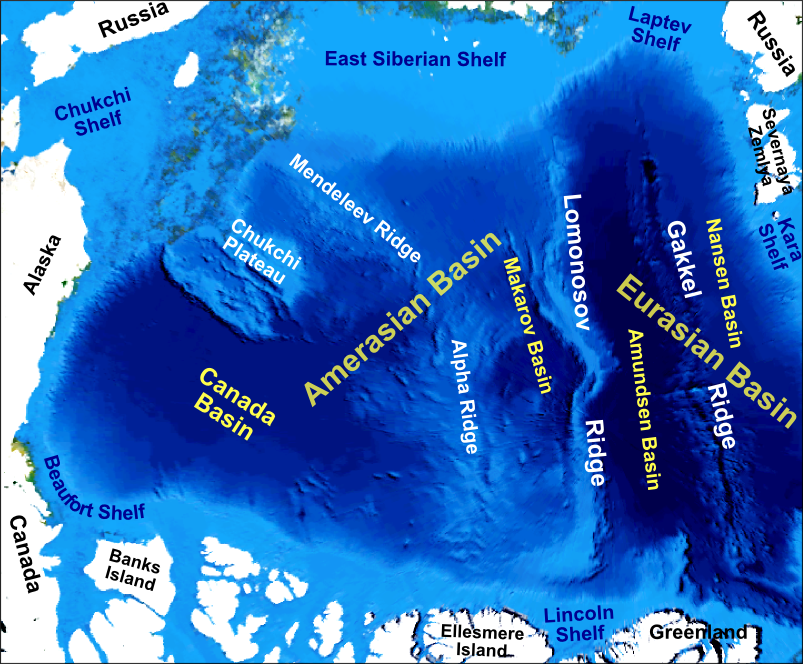
Gakkel Ridge highlighted on map of main bathymetric features of the Arctic Ocean, taken mainly from Weber 1983 ‘Maps of the Arctic Basin Sea Floor: A History of Bathymetry and its Interpretation’ on a base of a screenshot taken from the NASA WorldWind software.
“China is determined to participate in Arctic governance and that it has legitimate interests and rights in the region.”
In recent years, China has defined itself as “a near Arctic state.” Official Chinese statements have stressed that the Arctic belongs to the world and that China, as the world’s most populous state, is not content to let the nations of the Arctic Council, of which China is an observer, control the Arctic. As the excerpted article from the Norway-based The Barents Observer notes, China has dispatched the Xuelong-2 [R1] icebreaker ship to the Arctic. China is promoting the expedition as a scientific venture focusing on the Gakkel Ridge. However, recent Arctic initiatives with Russia[i] provide evidence that China is committed to a presence in the Arctic while strengthening China’s claims to Arctic resources.
Sources:
Atle Staalesen, “China’s icebreaker Xuelong-2 is sailing to the North Pole,” The Barents Observer (independent Norwegian news site in Russian and English currently blocked in Russia), 17 August 2023. https://thebarentsobserver.com/en/arctic/2023/08/chinas-icebreaker-xuelong-2-sailing-north-pole
China’s icebreaker Xuelong-2 is sailing to the North Pole
In cooperation with researchers from Russia and Thailand, Arctic experts from the Chinese Polar Institute are sailing 15,500 nautical miles on an expedition to the top of the world. It is the country’s 13th Arctic Ocean scientific expedition and the fourth voyage to the region by Xuelong-2, the new and fully Chinese-built icebreaker. On the 12th of July, the vessel set out from Shanghai. On the 17th of August it was breaking through the sea-ice at 84 °N.
One of the purposes of the expedition, organized by the Chinese Ministry of Natural Resources together with the Polar Institute, is to study geology and geophysics of the Gakkel Ridge. The researchers will also conduct investigations of atmospheric, sea ice, marine, and subsurface environmental surveys, as well as surveys of biomes and pollutants. According to Wang Jinhui, head of the expedition team, a key objective is to collect genetic specimens from the region. “We have isolated 130 strains of bacteria from the seawater and sediments and collected 68 genetic specimens of marine life to further enrich the polar gene bank and specimens of marine life. This also enhanced China’s capability in environmental protection and assessment of marine pollution in the Arctic Ocean,”
The vessel is a new ship with modern facilities for the researchers. The expedition team works in two shifts for 24 hours a day for about 40 days. A library and gym are on board the 122-meter icebreaker. A team of doctors provide medical services, and four chefs provide “a balanced diet for over 100 expedition members.” The expedition is conducted in cooperation with partners from Russia and Thailand. The icebreaker is due to return to Shanghai in late September.
Until 2020, the original Xuelong, an older Russian-built vessel, housed the Chinese Arctic expeditions, some of which proceeded along Russia’s Northern Sea Route, across the central Arctic Ocean, as well as through Canada’s Northwest Passage.During the Arctic Circle China conference in 2019, Chief of China’s State Oceanic Administration underlined that “protecting the Arctic environment is a common responsibility and China will make its contribution to this.” He also stressed that China sees itself as “a near-Arctic state” and it will “actively participate with wisdom and strength to future protection and development.” In early 2018, the country adopted an Arctic policy that highlights joint efforts and cooperative approaches, and at the same time underlines that China is determined to participate in Arctic governance and that it has legitimate interests and rights in the region.
Notes:
[i] For more information on China-Russia initiatives in the Arctic, see: Les Grau, “Russia and China Expanding Coast Guard Cooperation in Arctic,” OE Watch, 07-2023. https://fmso.tradoc.army.mil/2023/russia-and-china-expanding-coast-guard-cooperation-in-arctic/
Image: Gakkel Ridge highlighted on map of main bathymetric features of the Arctic Ocean, taken mainly from Weber 1983 ‘Maps of the Arctic Basin Sea Floor: A History of Bathymetry and its Interpretation’ on a base of a screenshot taken from the NASA WorldWind software.
Source: Mikenorton, https://en.wikipedia.org/wiki/Gakkel_Ridge – /media/File:Arctic_Ocean_bathymetric_features.png (modified by Combat Films and Research to feature Gakkel Ridge as permission granted by CC By-SA 3.0
Attribution: CC By-SA 3.0
